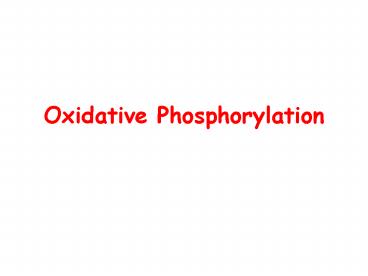Oxidative Phosphorylation - PowerPoint PPT Presentation
1 / 45
Title:
Oxidative Phosphorylation
Description:
Properties of 2,4-Dinitrophenol. Lipophilic Weak Acid. Proton ... Previous use of 2,4-dinitrophenol as dietary aid abandoned due to occasional lethality ... – PowerPoint PPT presentation
Number of Views:227
Avg rating:3.0/5.0
Title: Oxidative Phosphorylation
1
Oxidative Phosphorylation
2
Electron Transport and ATP Synthesis
ATP Synthase (Complex V)
3
Coupling of Electron Transport and ATP Synthesis
- In intact mitochondria, electron transport
requires simultaneous synthesis of ATP
4
Chemiosmotic Theory
- Peter Mitchell
- Links Electron Transport to ATP Synthesis
5
Evidence Supporting Chemiosmotic Theory
- Oxidative Phosphorylation requires an intact
mitochondrial inner membrane - Mitochondrial inner membrane is impermeable to
ions can maintain an electrochemical gradient - Electron transport acidifies the cytosol
- Uncouplers permeabilize the mitochondrial inner
membrane and uncouple electron transport and
oxidative phosphorylation
6
Electron Transport Generates a Proton
Gradient(Proton Motive Force)
- ?G 2.3RT?pH ZF??
- membrane potential
- ?pH 0.75 (inside higher)
- ?G 21.5 kJ/mol
7
ATP Synthesis
8
ATP Synthase
- Proton-pumping ATP Synthase
- F1F0ATPase
9
Properties of ATP Synthase
- Multisubunit transmembrane protein
- Molecular mass 450 kD
- Functional units
- F0 water-insoluble transmembrane protein (up to
8 different subunits) - F1 water-soluble peripheral membrane protein (5
subunits)
10
Structure of ATP Synthase(Electron Micrograph of
Cristae)
11
Structure of ATP Synthase(Cryoelectron
Microscopy-Based Image)
12
F1 Component of ATP Synthase
- Dissociated from F0 by urea
- Catalyzes ATP hydrolysis (ATPase) but cannot
synthesize ATP (F1-ATPase) - Pseudo three-fold symmetry
- Composition ?3?3???
- ? subunit catalyzes ATP synthesis
13
Ribbon Diagram of F1ATP Synthase from Bovine
Heart Mitochondria
? Red ? Yellow ? Blue
14
Electron Density Map of F1ATP Synthase from
Bovine Heart Mitochondria
Bound AMPPNP
15
F0 Component of ATP Synthase
- Includes a transmembrane ring
- Composition (E. coli) a1b2c9-12
- Mitochondrial F0 has additional subunits
(function unclear)
16
X-Ray Structure of Yeast Mitochondrial F1c10
Complex
17
F1ATPase
- Three Interacting Catalytic Protomers (??)
18
Properties of F1 Catalytic Protomers
- L state binds substrates and products loosely
- T state binds substrates and products tightly
- O state open state does not bind substrate or
product
19
ATP is Synthesized by the Binding Change Mechanism
L loose state T tight state O open state
20
Functions of Catalytic Protomers in ATP Synthesis
- L state binds substrates (ADP and Pi)
- T state formation of phosphoanhydride bond (ADP
Pi gt ATP) - O state release of product (ATP)
- Proton translocation drives interconversion of
states
21
Steps in ATP Synthesis
- ADP and Pi bind to L site
- Energy-dependent conformational change
- L gt T
- O gt L
- T gt O
- ATP synthesized at T site and ATP released from O
site
22
Proton Translocation Drives Interconversion of
States
23
F1F0ATPase is a Rotary Engine
Stator (ab2?3?3?)
Rotor (??c12)
24
F1F0ATPase is a Rotary Engine
- Rotor ??-c12 ring complex
- Stator ab2-?3?3?
- Movement of protons drives rotation
- Bind to c subunit
- Exit through a subunit
25
Rotation of F1F0ATPase
Protonation/ Deprotonation
Rotation
26
Visualizing Rotation
27
Visualizing Rotation
28
P/O Ratio
- Relates the Amount of ATP Synthesized to the
Amount of Oxygen Reduced
29
P/O Ratios Measured Using Isolated
Mitochondria(only use of proton gradient)
- NADH 3 ATP/10 H
- FADH2 2 ATP/6 H
30
Mitochondrial Electron Transport Chain
Complex II (FADH2)
31
Other Fates of Proton Gradient
- Dissipation (leakage)
- Consumption for other purposes (e.g. Pi transport)
32
Actual ATP Yields
- NADH 2.5 ATP
- FADH2 1.5 ATP
33
ATP from Glucose
- Glycolysis 2 ATP 2 NADH ( 5ATP) 7 ATP
- Pyruvate Dehydrogenase 2 NADH ( 5 ATP) 5 ATP
- Citric Acid Cycle 6 NADH ( 15 ATP) 2 FADH2 (
3 ATP) 2 GTP ( 2 ATP) 20 ATP - TOTAL 32 ATP/Glucose
34
Thermodynamic Yield
ATP/Glucose 32 ATP x 45 kJ/mol 1440
kJ Glucose gt CO2 2866 kJ 1440/2866 50
35
Uncouplers
- Electron Transport and Oxidative Phosphorylation
are Tightly Coupled
36
Tight Coupling
37
Properties of 2,4-Dinitrophenol
- Lipophilic Weak Acid
- Proton-transporting Ionophore
38
Action of 2,4-Dintrophenol
39
Uncoupling in Brown Adipose Tissue
- Generates Heat
40
Distribution of Brown Adipose Tissue
- Newborn mammals lacking fur
- Hibernating mammals
41
Nonshivering Thermogenesis(regulated uncoupling
of oxidative phosphorylation)
- Heat Generation
42
Uncoupling Protein(UCP1 or Thermogenin)
- Proton channel
- Inhibited by purine nucleotides
- ADP and ATP
- GDP and GTP
- Inhibition overcome by fatty acids
43
Mechanism of Hormonally-Induced Uncoupling of
Oxidative Phosphorylation in Brown Adipose Tissue
44
Mechanism of Hormonally-Induced Uncoupling of
Oxidative Phosphorylation in Brown Adipose Tissue
45
Adult Humans UCP2 and UCP3
- May be related to fast or slow metabolism
- Possible targets for anti-obesity therapies
- Previous use of 2,4-dinitrophenol as dietary aid
abandoned due to occasional lethality































